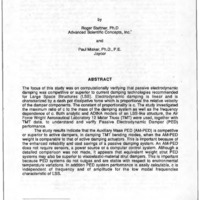-
Title
-
The Investigation Of Large Space Structure Passive Electrodynamic Dampers
-
Report Number
-
WL-TR-91-3078 Volume I, p. CAD-1 thru CAD-20
-
Creator
-
Stettner, Roger
-
Mlakar, Paul
-
Corporate Author
-
Advanced Scientific Concepts, Inc.
-
Jaycor
-
Laboratory
-
Wright Laboratory
-
Date
-
1991
-
Date Issued
-
1991-08
-
Extent
-
20
-
Contract
-
Laboratory Research - No Contract
-
DoD Project
-
2401
-
DoD Task
-
240104
-
Identifier
-
ADA241311
-
Format
-
1 online resource
-
Abstract
-
The focus of this study was on computationally verifying that passive electrodynamic damping was competitive or superior to current damping technologies recommended for Large Space Structures (LSS). Electrodynamic damping is linear and is characterized by a dash pot dissipative force which is proportional the relative velocity of the damper components. The constant of proportionality is c. The study investigated the maximum ratio of c to the mass of the damping system as well as the frequency dependence of c. Both analytic and ADINA models of an LSS-like structure, the Air Force Wright Aeronautical Laboratory 12 Meter Truss (TMT) were used, together with TMT data, to understand and verify Passive Electrodynamic Damper (PED) performance.
The study results indicate that the Auxiliary Mass PED (AM-PED) is competitive or superior to active dampers, in damping TMT bending modes, when the AM-PED weight is comparable to that of active damping actuators. This is important because of the enhanced reliability and cost savings of a passive_ damping system. An AM-PED does not require sensors, a power source or a computer control system. Although a detailed comparison was not made, it appears that equivalent weight strut PED systems may also be superior to viscoelastic-material strut dampers. This is important because PED systems do not outgas and are stable with respect to environmental temperature variations. In addition PED system performance is easily calculable, c is independent of frequency and of amplitude for the low modal frequencies characteristic of LSS.
-
Description
-
The focus of this study was on computationally verifying that passive electrodynamic damping was competitive or superior to current damping technologies recommended for Large Space Structures (LSS). Electrodynamic damping is linear and is characterized by a dash pot dissipative force which is proportional the relative velocity of the damper components. The constant of proportionality is c. The study investigated the maximum ratio of c to the mass of the damping system as well as the frequency dependence of c. Both analytic and ADINA models of an LSS-like structure, the Air Force Wright Aeronautical Laboratory 12 Meter Truss (TMT) were used, together with TMT data, to understand and verify Passive Electrodynamic Damper (PED) performance.
The study results indicate that the Auxiliary Mass PED (AM-PED) is competitive or superior to active dampers, in damping TMT bending modes, when the AM-PED weight is comparable to that of active damping actuators. This is important because of the enhanced reliability and cost savings of a passive_ damping system. An AM-PED does not require sensors, a power source or a computer control system. Although a detailed comparison was not made, it appears that equivalent weight strut PED systems may also be superior to viscoelastic-material strut dampers. This is important because PED systems do not outgas and are stable with respect to environmental temperature variations. In addition PED system performance is easily calculable, c is independent of frequency and of amplitude for the low modal frequencies characteristic of LSS.
-
Distribution Classification
-
1
-
Distribution Conflict
-
No
-
DTIC Record Exists
-
No
-
Illinois Tech Related
-
No
-
Report Availability
-
Full text available
-
Type
-
article
 article15
article15